Image credit to Wizards of the Coast
Dungeons and Dragons is back. Bigger and badder than ever, D&D is taking the tabletop community by storm all over again. Polished and shined over the past four decades, this role-playing wonder is worth your time. That being said, it can be an incredibly expensive hobby. From buying dice towers to expensive campaign books, this game can easily score a critical hit on your wallet. But, don’t worry. We’ve got you covered. Check out our guide down below to learn how to get into the greatest role-playing game of all time while on a budget.
Overview
In this guide, we will break down the basics of each major decision you will make when creating your character. The first decision you will likely make is choosing a background. You will, however, also need to choose your alignment, race, class, ability points and items.
In order to understand these choices in detail, as well as the base mechanics of D&D, you will need to get your hands on the game’s rule set. So, let’s talk about how you can get all of the information you need.
How to Access Your Character Sheet

For starters, you are going to want to snag a character sheet. A D&D character sheet is a player’s guide to all of their character’s stats and abilities, making it an integral part of this process. Luckily Wizards of the Coast offers a free PDF version of the official D&D character sheet for fifth edition. The sheet can be found here, along with many other useful things.
Once you have clicked on the link, click on “Fifth Edition Character Sheets” to download the zip file that contains the sheet. From there, open the zip file and click on “Character Sheet — Form Fillable.” This is the standard character sheet you will be using. An illustration of the sheet can be seen to the right.
How to Access D&D Information
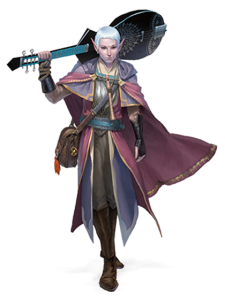
The next thing you are going to want to get your hands on are rule books, campaign guides and additional content. Now Dungeon and Dragons parent company Wizards of the Coast offers a series of different campaign guides, and each of these guides come with exciting adventures for your group to enjoy. Beyond that, there are also rule books that feature the basic mechanics of the game and supplemental books that add new sub-classes, items and other things to your adventure.
If you want to see every single official book that you can get your hands on, you can check them out at D&D Beyond right here. D&D Beyond is a nifty service that allows you to digitize the entire experience. You can even purchase an all-inclusive package through the service that includes a digital version of every fifth edition D&D book. However, this “Legendary Bundle” will set you back a whopping $454.15.
If you do not wish to pay full price for your books or you simply prefer physical copies, D&D books can often be purchased at your local tabletop game store. D&D books can also be purchased in popular bookstores such as Barnes and Noble. However, you are more likely to get a better deal at your local tabletop store if you want to shop in person. Amazon and eBay are both wonderful options if you do not mind buying used books, as this will most likely be your cheapest avenue for a physical copy. That being said, there are also some free options you can explore.
If you want free campaigns to play, you can find many great fan-made campaigns online. A list of free official D&D adventures can be found here. That being said, the beauty of D&D is that you can also make your own campaigns.
For a free online directory of various D&D facts and rules, you should check out 5esrd.com and roll20.net. These sites are great tools for new and experienced D&D players alike.
It is important to note, however, that Wizards of the Coast would obviously prefer you purchase your material rather than use free, official or unofficial online D&D sources. Consequently, no single free online source is entirely inclusive of D&D’s many features. Still, these free tools can be great ways to get started in D&D without breaking the bank.
Here’s What You Will Need to Play
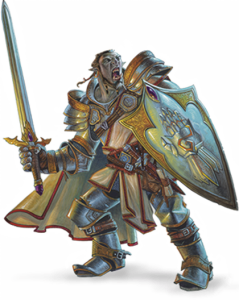
In order to play Dungeons and Dragons, you will need a few things. Among them, you will need a seven-piece dice set. Your local tabletop store will likely sell these dice sets for approximately $10 a set. Beyond that, you will need a pencil and a notebook. Luckily, neither of these items are terribly expensive or hard to find. You local grocery store likely sells both for rather cheap. Lastly, many players will spend small fortunes on character miniatures. However, you can achieve the same basic effect by using small household items. I personally like to use unique bottle caps to represent player characters and NPCs.
If you do not want to spend money on pencils, paper or dice, there are ways around having to open your wallet. Wizards of the Coast actually offers a free dice rolling program that digitally simulates a dice roll, making physical dice no longer necessary. The nifty tool can be found here.
If you have no issue using a laptop or tablet that’s lying around, then you can avoid having to spend money on pencils or paper. Another option is to remove the physical element of D&D entirely.
The previously mentioned website roll20.net offers a system that turns D&D into an entirely virtual experience. Many players prefer playing together at a table, but this option can still be an easy and inexpensive way to get into D&D whenever you want to have fun with long-distance friends. The nifty tool can be accessed here.
How to Meet for a D&D Game on a Budget
If you choose to physically meet up for your D&D games, then you have a few options for public playing. First, most of your local tabletop stores likely host weekly D&D nights in which players are welcomed to use their space to play for free. These gaming stores are inviting people to play in hopes that they will buy D&D related products during their stay.
Other than that, the park can be a fun place to play on a cool, sunny day. If you are playing with close friends, then the comfort of home can be a welcoming place. At any rate, there should never be a need to rent a space to sit down and play with your friends.
Also, consider setting up a payment system with your players. For instance, the dungeon master often has to spend an hour preparing for every hour everyone plays. Consequently, being a dungeon master can be a lot of work. Consequently, perhaps the dungeon master can be exempted from paying for food or drinks during the game.
At any rate, try setting up a fair payment system so that buying food and drinks for the gaming party isn’t too expensive.
Choosing a Character
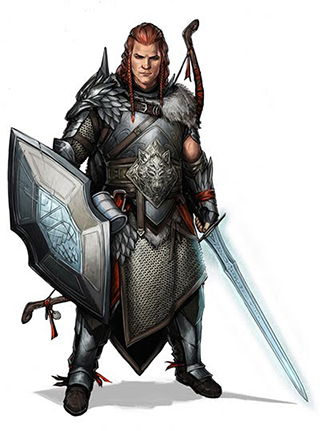
Now that you have your character sheet and you have access to all of the D&D information you will need to familiarize yourself with the game, you are ready to get started with your character.
Building a character in Dungeons and Dragons is an exercise in creativity all on its own. There is no right or wrong way to build a character. The beauty of this process is that you can use D&D’s character building system to play out whatever role-playing fantasy you desire. To that end, we have broken down the character building process into its six basic parts. Each part is another crossroad that will drastically shift the direction your character will take, making the character that much more unique and satisfying to play.
How to Choose Your Background

There are quite a number of backgrounds to choose from, as illustrated above. Each character gets one background of their choice. Each background provides a perk to enhance your character.
It will not immediately be obvious which gifted perks are the most important, but any background that provides additional skill proficiencies is generally quite useful. That being said, many D&D players choose their background based on their role-playing rather than the given stat boosts or perks.
How to Choose Your Alignment
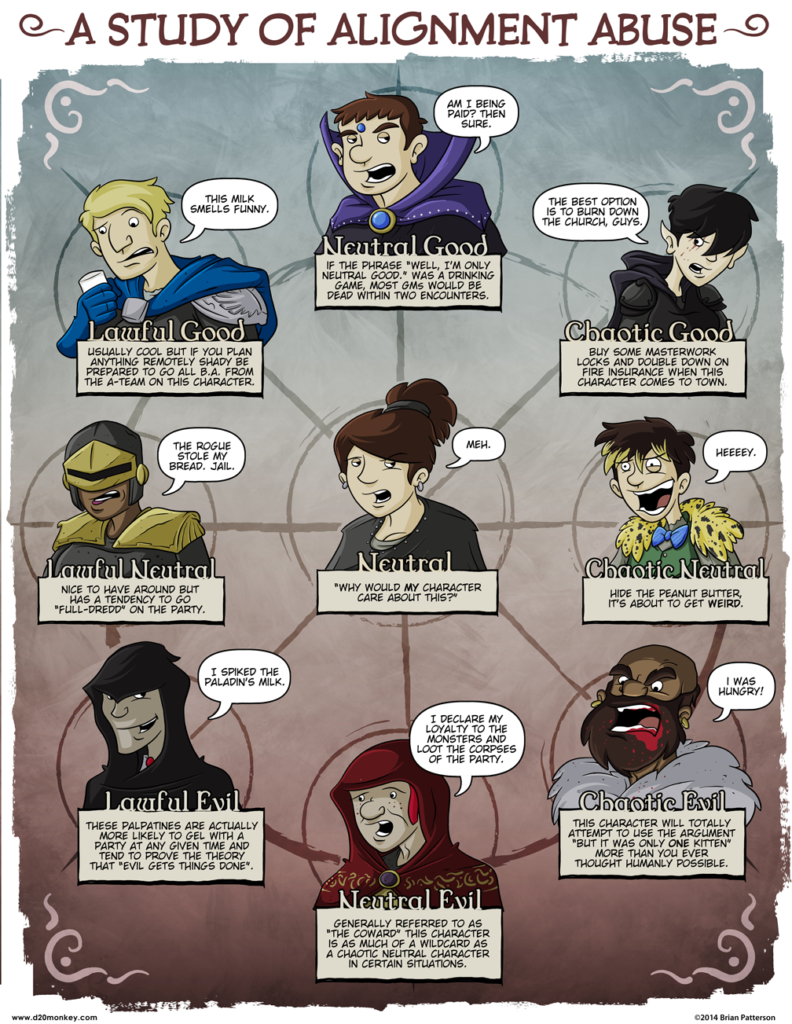
The next choice is going to be your alignment. This option has cultivated more than a few philosophical quandaries among players over the years.
Your alignment defines your character’s broad sensibilities and general perspective. In total, there are nine options. You can only choose one.
Choosing an alignment is about choosing how you want to role-play your character, rather than how to enhance your character’s ability in combat. Some players stick rather strictly to the alignment system when playing their characters. However, many players simply use the alignment system as a kind of guideline. At any rate, here is a quick rundown of each choice.
| Alignment | Description |
| Lawful Good | These characters play by the rules. Rather its governmental laws or religious rites, these characters abide by strict codes of conduct that often promote righteousness and prosperity. |
| Neutral Good | These characters aim to control the balance between good and evil. When given a chance, they will often tip that scale in favor of goodness. |
| Chaotic Good | These characters are less predictable than others. While they may have the best of intentions, they will often achieve their goals by any means necessary. |
| Lawful Neutral | These characters abide by a specific code that favors the natural balance between good and evil. |
| Neutral | These characters are passive, as they often wish to simply allow the natural balance of good and evil to persist. |
| Chaotic Neutral | These characters are often highly impulsive and difficult to predict. Often motivated by their base instincts, these characters can be grand inspirations of selflessness and apathetic evil all within the same afternoon. |
| Lawful Evil | These characters abide by strict codes of conduct that favor evil. |
| Neutral Evil | These characters wish to control the balance between good and evil, in order to shift things in the favor of evil. |
| Chaotic Evil | These characters are less predictable than their counterparts. That being said, these characters are often motivated by selfish and evil impulses. |
How to Choose Your Race

As illustrated above, there are quite a few races to choose from when making your class. That being said, new players can rule out quite a few of these options.
Just as they sound, “Monster” races are generally reserved for NPC monsters. Some players enjoy using these races to make their characters in order to create more unique experiences. That being said, you would likely first have to work it out with your Dungeon Master before choosing one of these races.
The “Exotic” races are also generally avoided by new players, as they can be a little more complicated. That being said, don’t be afraid to branch out if any of these races catch your eye.
The “Common” races are likely going to be where you want to focus your efforts, however. Just like with the other choices at your disposal, choosing your race should largely be based on how you want to role-play. Each race offers unique perks and abilities.
How to Choose Your Class
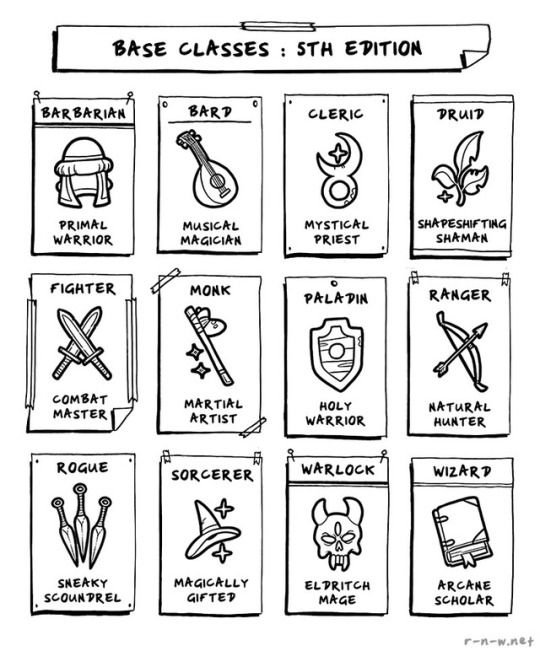
Choosing your class will likely be the toughest part of the character building process. Each class is incredibly unique and constructed with an in-depth system of distinctive skills and abilities. A common strategy among players for choosing a class is to first imagine what kind of character you want to play. Then, take a quick glance at just the class names. From there, consider which class will most likely match the character idea in your head. For instance, players looking to role-play someone like Lord of the Rings’ Aragorn would likely enjoy playing a fighter or a ranger. Likewise, a player looking to role-play a character more like Gandalf would likely enjoy a warlock or a sorcerer. A Harry Potter fan would likely fall in love with the wizard.
That being said, combat is also a huge part of the Dungeons and Dragons experience. Consequently, many players also enjoy choosing their class based on the class’ abilities and overall effectiveness in combat. If you want an in-depth break down of how each class stacks up in combat, check out our official D&D Class Tier List.
Otherwise, we have provided a quick breakdown of how each class generally functions in combat down below.
| Class | Description |
| Barbarian | Tank/Damage Dealer/Mobile |
| Bard | Support/Crowd Control/Buffs/Debuffs/Healing |
| Cleric | Support/Healing/Buffs |
| Druid | Support/Healing/Damage/AoE |
| Fighter | Damage/Tank |
| Monk | Mobile/Damage/Crowd Control |
| Paladin | Tank/Damage/Support |
| Ranger | Damage |
| Rogue | Damage/Mobility |
| Sorcerer | Damage/AoE |
| Warlock | Damage/AoE |
| Wizard | Damage/AoE |
How To Choose Your Ability Points
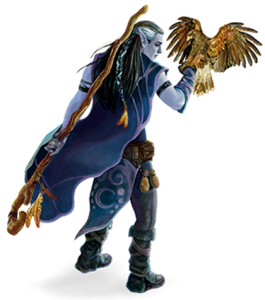
The second toughest choice you will face is picking your ability points. These can be a bit tricky for new players.
Each ability represents a series of different combat and non-combat modifiers. For instance, your strength score will determine your effectiveness with strength based skills such as Athletics. However, the ability will also determine your combat effectiveness with most melee weapons and will determine your carry weight.
When it comes to choosing your ability points, there are three basic systems. The standard array system allows for a player to choose between six different totals for each of their six ability scores. Specifically, a player is given the values of 15, 14, 13, 12, 10 and 8. Each of these scores must be allocated to one of the six abilities. This system is preferred by many new D&D players due to its simplicity and effectiveness.
The point buy system is a little more complicated, but still appreciated by many D&D players. Each score is immediately set to eight. From there, the player has 27 points to boost their ability scores with. The trick, however, is that ability values cost more points the higher they become. For instance, raising your strength from eight to 15 would cost a total 15 of your 27 points.
Lastly, there is the rolling system. This system can be a lot of fun. The player rolls four six sided die, or d6s, to rack up each of their ability scores. After the die are rolled, remove the lowest value and add up the remaining three die rolls. This will determine your ability score. For instance, rolling four d6s for strength may end in a 2, 5, 6 and a 1. We would remove the die that rolled on a one, as that is the lowest value. Adding up the rest of the die rolls, we would ultimately end up with a strength score of 13.
Continue this process until you have rolled all six of your ability scores. If you are unhappy with your results, many dungeon masters will permit their players a set number of chances to re-roll all of their ability scores.
However your group decides to pick their ability scores, here is a quick rundown of each ability. It is important to note that each ability also has an associated saving throw.
| Ability | Description |
| Strength | This will determine your effectiveness with most melee weapons, your ability with certain skills, your ability to grapple targets and your carry weight. |
| Dexterity | This will determine your armor class, initiative, effectiveness with finesse and ranged weapons and ability with certain skills. |
| Constitution | This will determine your maximum health. |
| Charisma | This will determine your spellcasting effectiveness for certain classes and your effectiveness with certain skills. |
| Wisdom | This will determine your spellcasting effectiveness for certain classes and your effectiveness with certain skills. |
| Intelligence | This will determine your spellcasting effectiveness for certain classes and your effectiveness with certain skills. |
How to Choose Your Skill Proficiencies
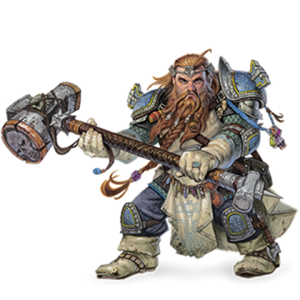
Each class comes equipped with a few choices. You can choose from a selection of saving throw proficiencies and skill proficiencies. The particular proficiencies you can choose between will vary from class to class. The saving throw proficiencies are not tough choices. A saving throw is performed as a reaction to certain actions. For instance, a wizard may cast a fireball spell at your barbarian. The barbarian can make a dexterity saving throw to try and dodge out of the way. On a successful save, the barbarian will only take half damage. The most important saving throw abilities are wisdom, dexterity and charisma.
Skill checks, on the other hand, are made whenever a character attempts to perform an impressive feat. For instance, a rouge could try and complete a back-flip in order to impress a nearby bystander. This would likely incur an acrobatics skill check. The dungeon master will determine precisely when skill checks will be necessary.
Each ability determines a character’s effectiveness with certain skill checks. Consequently, it is best to match your chosen skill proficiencies with abilities that have high scores. A list of each skill associated with each ability can be seen below.
Strength
- Athletics
Dexterity
- Acrobatics
- Sleight of Hand
- Stealth
Intelligence
- Arcana
- History
- Investigation
- Nature
- Religion
Wisdom
- Animal Handling
- Insight
- Medicine
- Perception
- Survival
Charisma
- Deception
- Intimidation
- Performance
- Persuasion
How to Choose Your Items
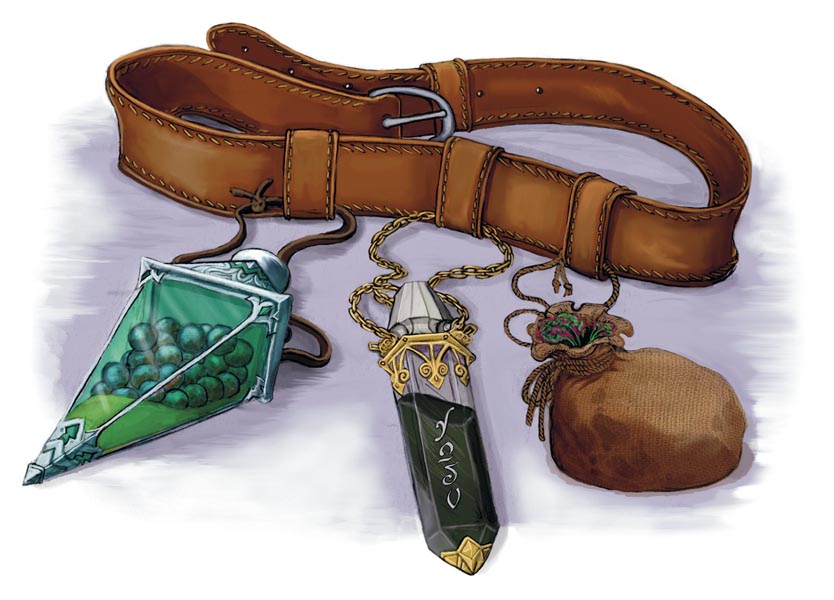
The final choice for your character will be your items. Each character is granted a certain amount of starting gold and a selection of gear. The class and background chosen for your character will dictate these options and values. For instance, a barbarian class has the following starting gear options.
• (a) a greataxe or (b) any martial melee weapon
• (a) two handaxes or (b) any simple weapon
• An explorer’s pack and four javelins
When choosing your weapons, you want to make sure you are proficient with the item. Each class has a different list of proficiencies concerning tools, skills, saving throws, weapons and armor. Beyond that, you will want to pay attention to if the weapon is melee, finesse or ranged.
A melee weapon uses the strength ability to determine its effectiveness. Both finesse and ranged weapons use dexterity to determine their effectiveness. For a full list of adventuring gear options, check out the link provided here.
How to Fill Out Your Character Sheet
Once you have chosen a background, race, alignment, class, saving throw proficiencies, skill proficiencies and starting gear, you will be done building your level one character. All that will be left is filling out the character sheet mentioned above. Each decision you have made up to this point will dictate what each empty value within the sheet will become.
In order to familiarize yourself with the basics of Dungeons and Dragons so that you can calculate your final stats within the character sheet, check out the free, official basic rules guide for D&D here.
Things To Consider As Your Character Levels
As you level up in Dungeons and Dragons, you will be faced with more character choices. For instance, every four levels, a player has the option to increase their character’s ability scores or to learn a feat. At level three, a player must choose from a selection of sub-classes for their character. In the end, it is an ever-evolving process building your character.
If you would like to learn how to build some of D&D’s top tier classes for combat all the way to max level, then check out the GameTruth guides down below.
For all your D&D needs, check out Dungeons and Dragons Guides Portal – Anything and Everything D&D.

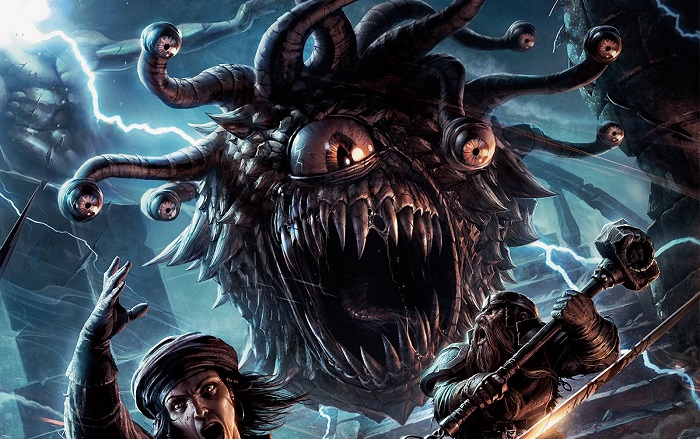
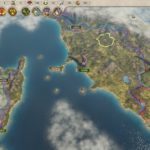




Comments are closed.